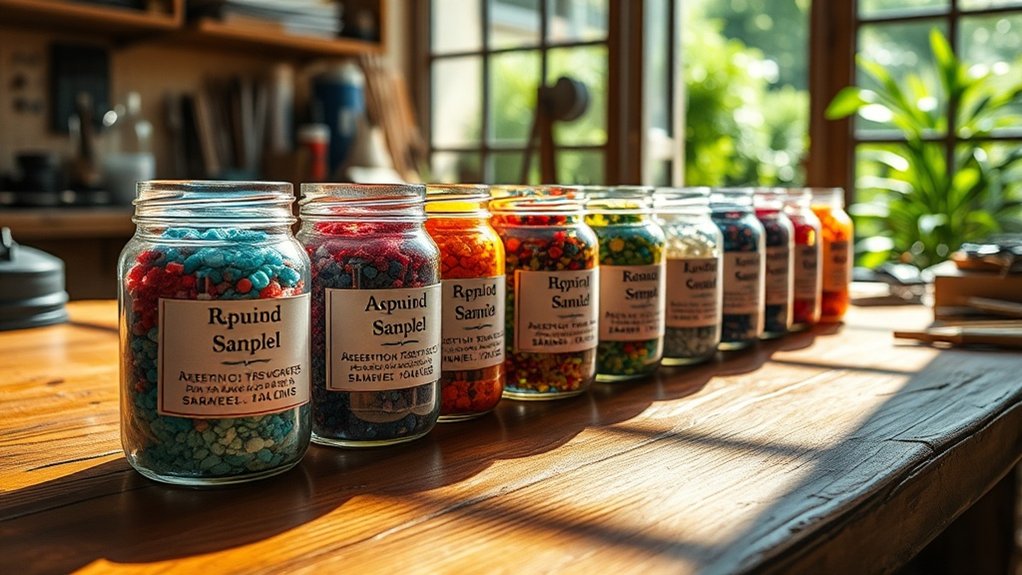To source custom resin-bound gravel for your project, begin by identifying suppliers who provide tailored options and quality materials. Ensure you select a mixture of angular, clean aggregates combined with high UV-stable resin for enhanced durability and appearance. Assess suppliers based on their material composition, availability of anti-slip additives, and their ability to customise mixes. Proper installation is crucial, so consider hiring certified professionals. There’s plenty to discover about the advantages, design options, and safety standards that can improve your project.
Key Takeaways
- Look for suppliers who offer customisation options and a range of aggregate blends suited to your project’s needs.
- Ask suppliers for samples and advice on colour choices and design ideas to complement your vision.
- Check that the resin you choose meets REACH regulations and is UV stable to avoid discolouration over time.
- Assess suppliers based on their technical support, installation training, and compliance with quality standards like FeRFA.
- Explore sustainable options, including bio-based resins and recycled aggregates, to support eco-friendly practices in your project.
Understanding Resin-Bound Gravel Kits
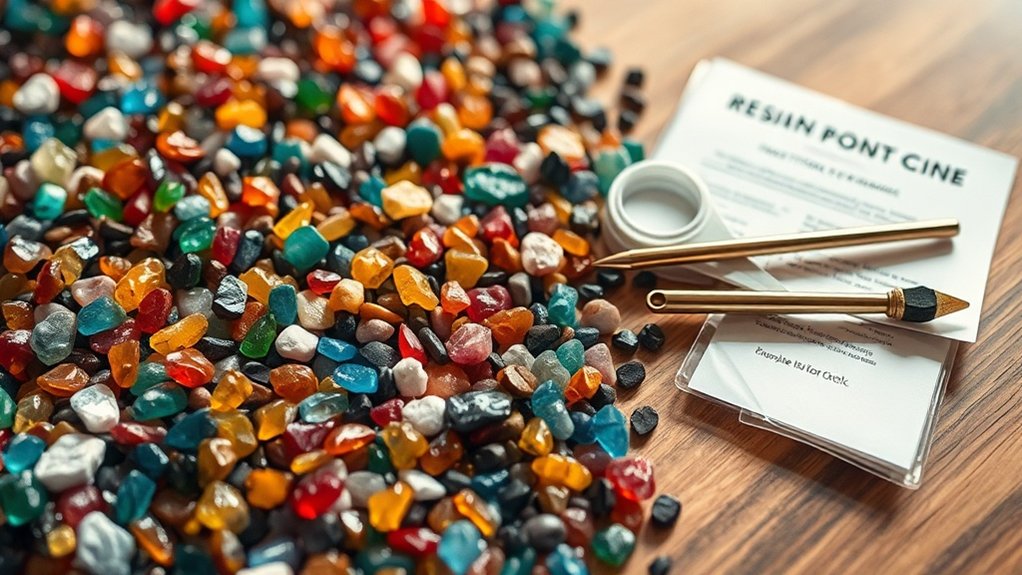
When considering a resin-bound gravel kit for your project, it’s important to know what it includes. Most kits come with a pre-measured two-part polyurethane resin, which provides essential strength, and a bag of aggregate stones sized between 2-5mm and 1-3mm. These stones enhance the surface texture and durability. The resin typically makes up about 7% of the weight of the aggregate; using too little can compromise the surface’s strength. Additionally, ensuring proper surface preparation is vital for effective resin bonding and overall project success. Many kits also include an anti-slip glass grit additive for better traction. You can also choose between UV-resistant or non-UV resin, depending on your finish needs. Understanding these components ensures you achieve a durable and attractive surface, making resin-bound paths a popular choice for enhancing outdoor spaces.
Benefits of Resin-Bound Gravel for Various Applications
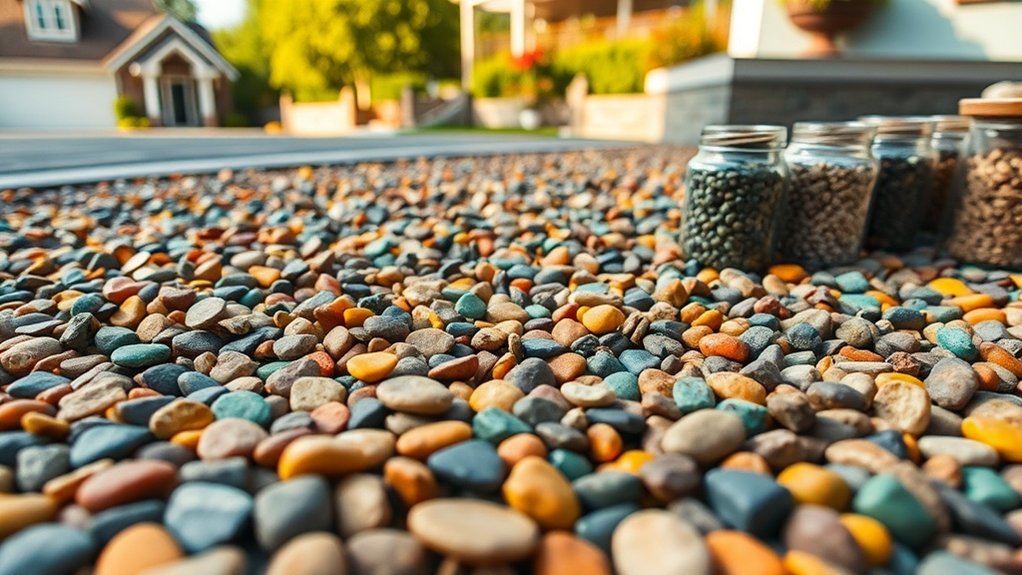
Resin-bound gravel offers more than just a pleasing appearance; it provides numerous practical benefits for various uses.
Its durability and low maintenance align with the growing demand for hassle-free solutions. The seamless finish prevents weeds and eliminates loose stones, creating a safer environment for both pedestrians and vehicles. Additionally, its smooth, seamless finish ensures accessibility for individuals with mobility challenges. This environmentally friendly option supports eco-friendly initiatives by incorporating sustainable aggregates.
You can use resin-bound gravel for driveways, pathways, or public areas, which can enhance the overall look of your property and increase its value.
Environmentally, its permeable design aids groundwater replenishment and helps reduce urban heat. Additionally, the range of colours available allows for unique designs that complement different landscapes.
Key Suppliers for Custom Resin-Bound Gravel
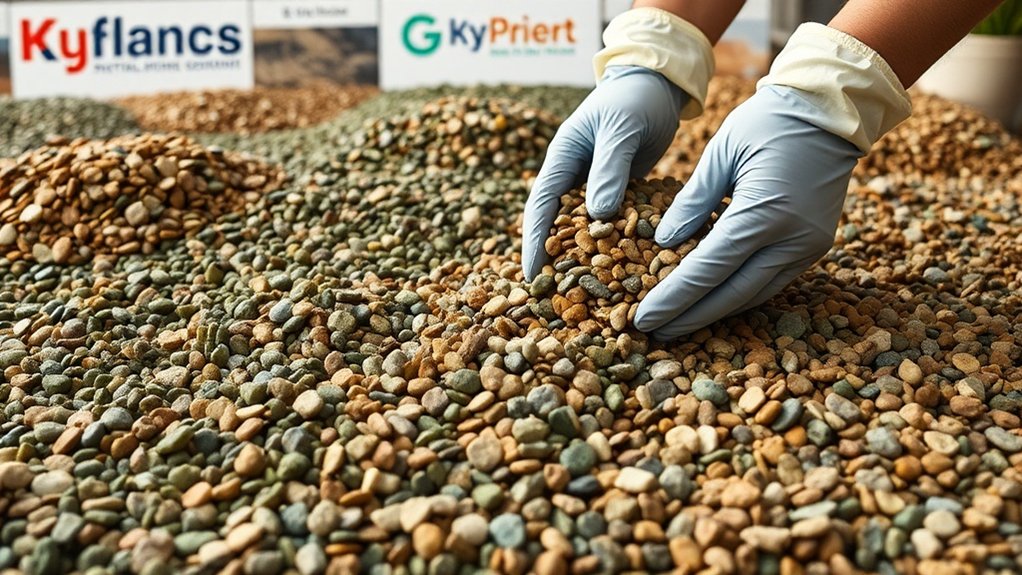
Choosing the right supplier for custom resin-bound gravel is crucial for the success of your project. A comprehensive evaluation of suppliers and market analysis is key. Here are some key suppliers to consider:
| Supplier | Product Focus | Notable Features |
|---|---|---|
| Stone Resin Surfacing Ltd | Permeable paving | Responsibly sourced materials |
| RYNO Systems | Resin-bound kits | Clear polyurethane resin |
| The Rubber Company | StonePour® flooring | Anti-slip properties |
These suppliers offer unique capabilities, including customisation options and technical support. Consider their environmental practices and distribution networks, as these can influence your project’s timeline and sustainability. Additionally, many suppliers utilize environmentally ethical sourcing methods for their aggregate binders, ensuring a reduced impact on the environment. Suppliers should also ensure compliance with REACH Regulations to promote health and environmental protection during your project.
Evaluating Material Composition and Quality
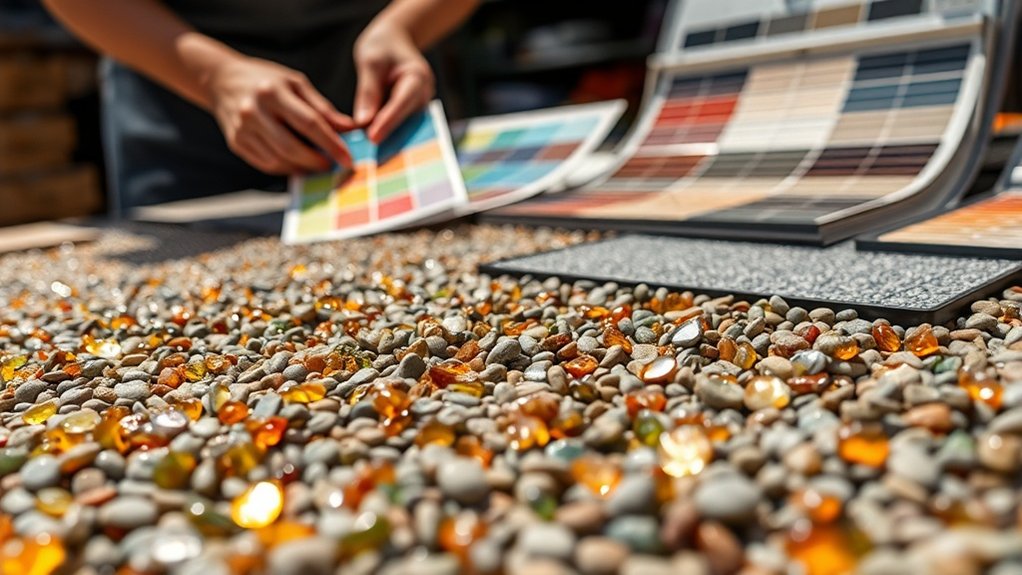
How do you ensure the highest quality and performance for your custom resin-bound gravel project? Start with careful material selection.
Choose the right type of resin—either epoxy or polyurethane—that offers UV stability to prevent yellowing. Aim for a resin-to-aggregate ratio of about 7% by weight for optimal strength.
When selecting aggregates, go for angular, clean, kiln-dried particles, as these improve bonding. A mix of different aggregate sizes can enhance anti-slip properties and overall durability.
Conduct thorough quality checks, including tests for tensile strength and resistance to UV degradation and freeze/thaw cycles.
Make sure your materials comply with standards like BS EN 12620. By focusing on these aspects, you’ll achieve a strong, long-lasting resin-bound surface that can withstand the test of time.
Installation Considerations for Resin-Bound Gravel
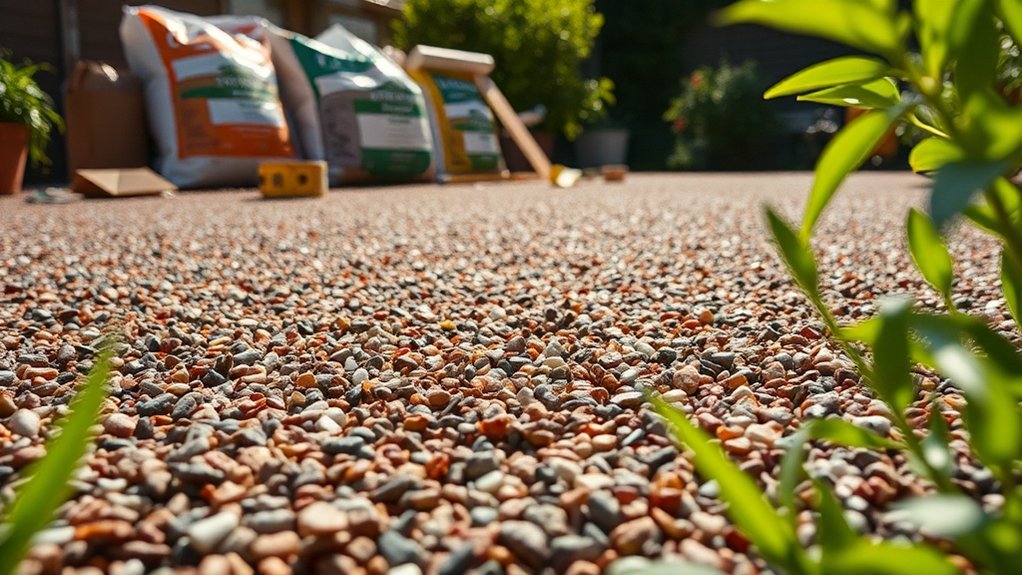
When starting a custom gravel installation, it’s crucial to focus on preparation and technique to ensure a durable and attractive surface.
Begin by cleaning and levelling the base, making any necessary repairs to prevent issues later on. For new builds, excavate and lay a solid sub-base for added stability.
During mixing, adhere carefully to the manufacturer’s instructions to achieve a consistent blend.
When spreading the resin-bound gravel, do so evenly, maintaining a steady depth as you work backwards from the site.
Curing is also important; allow the surface to set completely before use, keeping an eye on temperature and humidity.
Maintenance Tips for Long-Lasting Surfaces
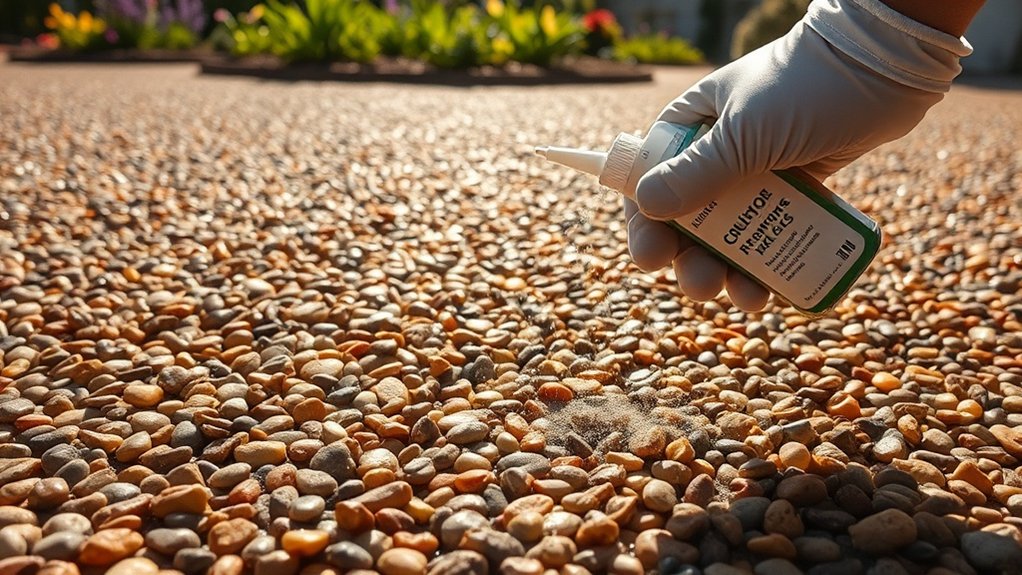
To keep your resin-bound gravel surface in good condition, set up a regular cleaning routine that includes sweeping and rinsing with a hose.
It’s also important to check for any signs of damage or wear and deal with these issues quickly to preserve the surface’s integrity.
Regular Cleaning Schedule
Maintaining a regular cleaning schedule is crucial for the longevity and appearance of resin-bound gravel surfaces.
Start by sweeping regularly, particularly in autumn, to effectively remove debris. Use a stiff broom and sweep in the direction of the aggregate pattern to maintain its integrity. Adjust your cleaning frequency after storms or during leaf fall.
For deeper cleaning, use a garden hose or a gentle pressure washer, keeping the pressure below 150 bar and maintaining a distance of at least 20 cm.
Seasonal tasks include rinsing in spring and summer to clear away pollen, while winter involves checking for ice formation.
Consistent maintenance will prevent long-term damage and keep your gravel looking its best.
Inspect for Damage
When inspecting your resin-bound gravel surfaces, it’s important to look out for any signs of damage that could affect their durability and appearance.
Start by checking for cracks, chips, or surface crazing, which can indicate wear and tear. Pay attention to loose aggregates and any fading of the resin gloss.
Inspect the edges for separation from the base and look for discolouration that might suggest chemical spills.
Additionally, ensure the underlying base is stable, as subsidence or moisture issues can lead to bigger problems.
Designing With Color Options and Aesthetics

When choosing colours for your resin-bound gravel, think about how different shades can enhance the overall look of your property.
You might blend earthy tones with vibrant colours for a striking contrast, or opt for sophisticated greys and silvers for a more cohesive appearance.
Thoughtful colour choices not only boost visual appeal but also reflect your personal style and the character of your surroundings.
For example, a warm terracotta hue can complement a rustic cottage, while sleek grey can modernise a contemporary home.
Color Selection Strategies
Choosing the right colour for your resin-bound gravel is essential. Start by thinking about colour psychology; the shades you pick can affect emotions and perceptions. For example, earthy tones like browns and beiges add warmth, while greys and silvers offer a contemporary feel.
Consider how the colour will harmonise with your home and surroundings. If your property has a traditional style, softer, mottled shades are ideal. For modern designs, uniform greys or striking accents work well.
Don’t forget maintenance: lighter colours tend to show dirt more easily, while darker shades conceal stains better.
Feel free to explore custom blends for a unique look that suits your style. Always consult suppliers for swatches and professional guidance to help refine your choice.
Aesthetic Design Ideas
When considering aesthetic design ideas for resin-bound gravel, think about how various colours and textures can enhance your outdoor areas.
The range of textures in resin-bound gravel allows for both visual appeal and tactile experiences. Here are some practical design tips:
- Opt for geometric patterns for a sleek, modern appearance.
- Use nature-inspired designs to blend seamlessly with your garden.
- Highlight borders with contrasting textures to create focal points.
- Differentiate areas with patterned layouts.
- Add a personal touch with custom logos or monograms.
These strategies not only boost aesthetics but also ensure practicality.
Safety Features and Standards Compliance
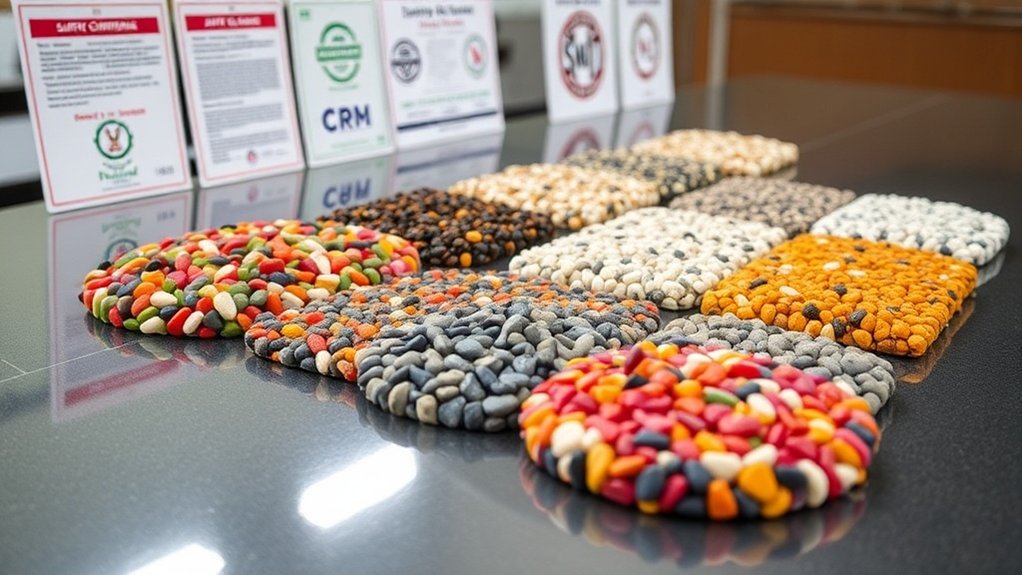
Ensuring safety features and compliance with standards is vital in any surfacing project, and resin-bound gravel stands out in these areas. Its natural slip resistance is key for outdoor safety, particularly in wet weather. By adding anti-slip materials during mixing, you can improve grip and meet or exceed safety standards for slip resistance, as confirmed by thorough testing.
Moreover, resin-bound gravel complies with Sustainable Urban Drainage Systems (SUDS) regulations, effectively managing water runoff and reducing the risk of flooding. This compliance helps prevent puddles and allows for groundwater replenishment.
To maintain these safety features, it’s crucial to follow the correct mixing ratios and installation guidelines. Incorrect practices can lead to surface issues and safety risks.
With proper care, you can achieve a durable, compliant surface for your project.
Certification and Training for Installation
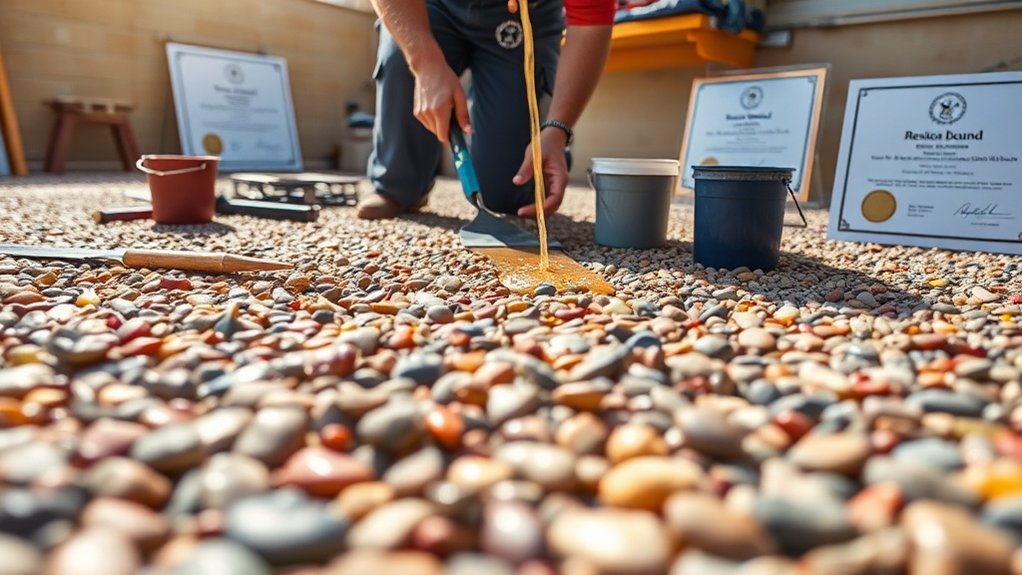
To ensure the successful installation of resin-bound gravel, obtaining the right certification and training is crucial. Understanding the significance of certification ensures compliance with regulations and enhances your skills.
Focus on effective training methods covering the following areas:
- REACH regulations and diisocyanate safety
- SUDS compliance for wet weather
- FeRFA guidelines for quality standards
- Practical training for mixing and application
- Regular audits to uphold standards
These elements not only boost your expertise but also establish your credibility with clients.
Completing recognised courses, such as those from Resin’Architecte, equips you with both practical experience and theoretical knowledge, leading to a smoother installation process and happier customers.
Future Trends in Resin-Bound Gravel Products
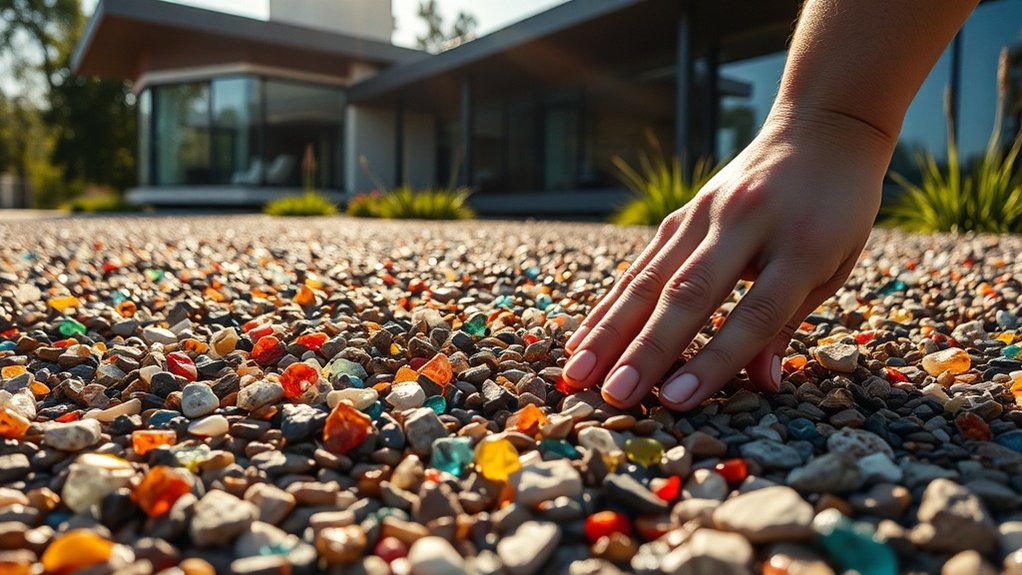
With certification and training firmly established, the future of resin-bound gravel products looks promising.
New technologies like improved resin chemistry and automated mixing systems are set to enhance durability and efficiency. We can anticipate a shift towards sustainable materials, with bio-based resins and recycled aggregates becoming common due to growing environmental concerns.
Digital visualisation tools will simplify project approvals, while advanced polymer blends will ensure compliance with stringent standards.
As the applications of resin-bound gravel expand, expect more customisation options that meet varied design needs, boosting both aesthetics and functionality.
Ultimately, these developments will lead to resin-bound gravel solutions that not only meet but surpass durability expectations, ensuring longevity across different climates.
Frequently Asked Questions
What Is the Typical Lifespan of Resin-Bound Gravel Installations?
Resin-bound gravel installations generally last between 15 to 25 years, provided they are well-maintained. To maximise their lifespan, it’s essential to use high-quality materials and ensure expert installation. Regular cleaning is also important, as it helps maintain the surface and protects against wear from environmental factors and everyday use.
Can Resin-Bound Gravel Be Recycled After Its Lifespan?
Yes, resin-bound gravel can be recycled at the end of its lifespan, which helps to reduce environmental impact. Up to 80% of the materials can be reclaimed, promoting sustainability and minimising waste. This recycling process conserves natural resources and supports eco-friendly practices.
How Does Weather Affect Resin-Bound Gravel Installation?
Weather can significantly impact your resin-bound gravel installation. Fluctuations in temperature and moisture levels can affect the curing process, potentially resulting in uneven surfaces. For best results, always check the forecast to ensure conditions are suitable for a long-lasting finish. For instance, aim for a dry day with temperatures between 10°C and 25°C for optimal curing.
Are There Specific Tools Required for Installation?
For a successful installation, you’ll need essential tools such as a drill with a paddle mixer, a forced action mixer, and trowels. Knowing how to use these tools properly ensures a smooth and durable resin-bound surface. Don’t overlook the importance of quality equipment for the best results.
What Are the Costs Associated With Resin-Bound Gravel Projects?
When planning your resin-bound gravel project, keep an eye on material costs, which generally range from £50 to £75 per square metre. Don’t forget to factor in expenses for labour, site preparation, and any potential extra costs if your project has unique complexities. For instance, if you’re working on a sloped area or require additional drainage solutions, these could increase your overall budget.
Conclusion
Incorporating custom resin-bound gravel into your project can truly elevate your outdoor space, creating a beautiful and inviting area. By choosing quality materials, researching suppliers, and ensuring proper installation, you can achieve a durable surface that looks fantastic and lasts long. As design trends change, you’ll discover numerous ways to showcase your personal style, making your project both practical and visually appealing. For instance, a vibrant resin-bound driveway can enhance your home’s curb appeal, while a subtle pathway can seamlessly blend with your garden.
